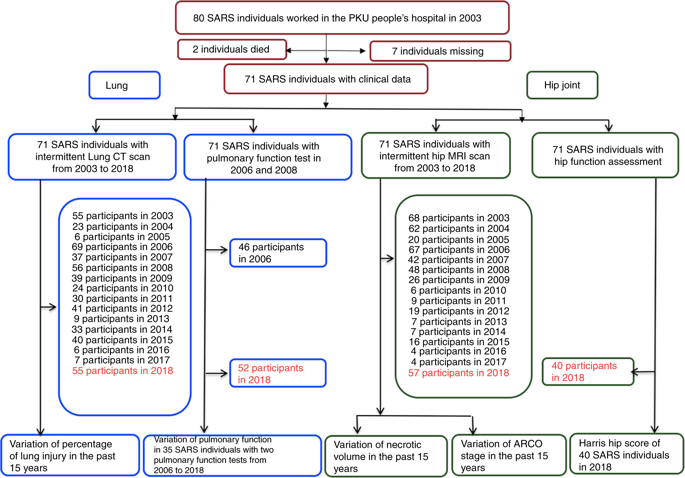Our official English website, www.x-mol.net, welcomes your
feedback! (Note: you will need to create a separate account there.)
Long-term bone and lung consequences associated with hospital-acquired severe acute respiratory syndrome: a 15-year follow-up from a prospective cohort study.
Bone Research ( IF 14.3 ) Pub Date : 2020-02-14 , DOI: 10.1038/s41413-020-0084-5 Peixun Zhang 1 , Jia Li 2 , Huixin Liu 3 , Na Han 4 , Jiabao Ju 5 , Yuhui Kou 1 , Lei Chen 6 , Mengxi Jiang 6 , Feng Pan 6 , Yali Zheng 2 , Zhancheng Gao 2 , Baoguo Jiang 1
Bone Research ( IF 14.3 ) Pub Date : 2020-02-14 , DOI: 10.1038/s41413-020-0084-5 Peixun Zhang 1 , Jia Li 2 , Huixin Liu 3 , Na Han 4 , Jiabao Ju 5 , Yuhui Kou 1 , Lei Chen 6 , Mengxi Jiang 6 , Feng Pan 6 , Yali Zheng 2 , Zhancheng Gao 2 , Baoguo Jiang 1
Affiliation

|
The most severe sequelae after rehabilitation from SARS are femoral head necrosis and pulmonary fibrosis. We performed a 15-year follow-up on the lung and bone conditions of SARS patients. We evaluated the recovery from lung damage and femoral head necrosis in an observational cohort study of SARS patients using pulmonary CT scans, hip joint MRI examinations, pulmonary function tests and hip joint function questionnaires. Eighty medical staff contracted SARS in 2003. Two patients died of SARS, and 78 were enrolled in this study from August 2003 to March 2018. Seventy-one patients completed the 15-year follow-up. The percentage of pulmonary lesions on CT scans diminished from 2003 (9.40 ± 7.83)% to 2004 (3.20 ± 4.78)% (P < 0.001) and remained stable thereafter until 2018 (4.60 ± 6.37)%. Between 2006 and 2018, the proportion of patients with interstitial changes who had improved pulmonary function was lower than that of patients without lesions, as demonstrated by the one-second ratio (FEV1/FVC%, t = 2.21, P = 0.04) and mid-flow of maximum expiration (FEF25%-75%, t = 2.76, P = 0.01). The volume of femoral head necrosis decreased significantly from 2003 (38.83 ± 21.01)% to 2005 (30.38 ± 20.23)% (P = 0.000 2), then declined slowly from 2005 to 2013 (28.99 ± 20.59)% and plateaued until 2018 (25.52 ± 15.51)%. Pulmonary interstitial damage and functional decline caused by SARS mostly recovered, with a greater extent of recovery within 2 years after rehabilitation. Femoral head necrosis induced by large doses of steroid pulse therapy in SARS patients was not progressive and was partially reversible.
中文翻译:

与医院获得性严重急性呼吸系统综合症相关的长期骨和肺后果:一项前瞻性队列研究的 15 年随访。
SARS 康复后最严重的后遗症是股骨头坏死和肺纤维化。我们对 SARS 患者的肺和骨骼状况进行了 15 年的随访。我们在一项针对 SARS 患者的观察性队列研究中,使用肺部 CT 扫描、髋关节 MRI 检查、肺功能测试和髋关节功能问卷评估了肺损伤和股骨头坏死的恢复情况。2003年有80名医务人员感染了SARS。2名患者死于SARS,2003年8月至2018年3月期间有78名患者参加了本研究。71名患者完成了15年的随访。CT扫描中肺部病变的百分比从2003年(9.40±7.83)%下降到2004年(3.20±4.78)%(P <0.001),此后一直保持稳定直到2018年(4.60±6.37)%。2006 年至 2018 年间,一秒比值(FEV1/FVC%, t = 2.21, P = 0.04)和最大呼气中流量表明肺功能改善的间质改变患者比例低于无病变患者(FEF25%-75%,t = 2.76,P = 0.01)。股骨头坏死体积从2003年(38.83±21.01)%到2005年(30.38±20.23)%(P=0.000 2)显着下降,然后从2005年到2013年缓慢下降(28.99±20.582),直至2005年的20.59%和20.59%。 ± 15.51)%。SARS引起的肺间质损伤和功能下降大多恢复,康复后2年内恢复较大。SARS患者大剂量类固醇冲击治疗引起的股骨头坏死不是进行性的,是部分可逆的。
更新日期:2020-02-14
中文翻译:

与医院获得性严重急性呼吸系统综合症相关的长期骨和肺后果:一项前瞻性队列研究的 15 年随访。
SARS 康复后最严重的后遗症是股骨头坏死和肺纤维化。我们对 SARS 患者的肺和骨骼状况进行了 15 年的随访。我们在一项针对 SARS 患者的观察性队列研究中,使用肺部 CT 扫描、髋关节 MRI 检查、肺功能测试和髋关节功能问卷评估了肺损伤和股骨头坏死的恢复情况。2003年有80名医务人员感染了SARS。2名患者死于SARS,2003年8月至2018年3月期间有78名患者参加了本研究。71名患者完成了15年的随访。CT扫描中肺部病变的百分比从2003年(9.40±7.83)%下降到2004年(3.20±4.78)%(P <0.001),此后一直保持稳定直到2018年(4.60±6.37)%。2006 年至 2018 年间,一秒比值(FEV1/FVC%, t = 2.21, P = 0.04)和最大呼气中流量表明肺功能改善的间质改变患者比例低于无病变患者(FEF25%-75%,t = 2.76,P = 0.01)。股骨头坏死体积从2003年(38.83±21.01)%到2005年(30.38±20.23)%(P=0.000 2)显着下降,然后从2005年到2013年缓慢下降(28.99±20.582),直至2005年的20.59%和20.59%。 ± 15.51)%。SARS引起的肺间质损伤和功能下降大多恢复,康复后2年内恢复较大。SARS患者大剂量类固醇冲击治疗引起的股骨头坏死不是进行性的,是部分可逆的。











































 京公网安备 11010802027423号
京公网安备 11010802027423号